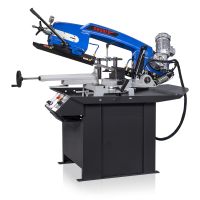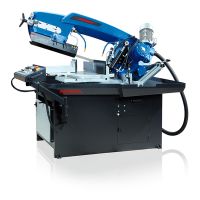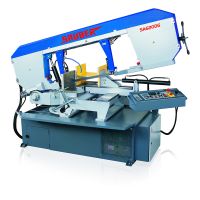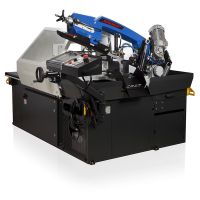Loading...
In this post, we explore the critical things to look out and consider when purchasing a horizontal-type metal cutting bandsaw machine.
Size Matters...
- First things first – the machine has to be big enough to handle the sizes you need to cut. If you’ll be cutting angles, remember the size capacity diminishes fairly rapidly. The bigger the wheels the bigger the size capacity….
- Blade size counts. The wider the blade, the higher the beam strength of the blade. Which means you can feed faster thereby reducing cutting times.
But so does Quality
- Next, consider the quality of the machine required. No point spending megabucks on a Rolls Royce when you are only using it a few times a week, a Mini Moke will do! But most WOLFMACH customers are serious engineers & do a serious amount of cutting. We have many customers who bought what seemed like the best deal, then a few months later they wished they had spent a bit more on a better machine. Check the quality of the machine & the country of origin. The comparable weight of machines is a good guide to quality level. The heavier the machine the more stable it should be.
- Is the saw arm cast or fabricated? Castings are more rigid. Larger high-quality machines will have a hollow fabricated saw arm, but how thick is the fabrication, & are there gussets & strengthening braces in place? Cheaper saws are built to a budget. Thinner steel & lack of strengthening members is an easy way to save the manufacturer money, & usually in the places you cannot easily see. High blade tension will soon ‘move’ light gauge saw arms & your cutting becomes inaccurate.
- Check motor size, coolant pump size, hydraulic system, blade-guide rigidity – are they more than adequate, & do the parts come from reputable sources?
- Do the side guides have ball bearings to take the twist out of the blade BEFORE the blade enters the carbide guide pads? If not, you can expect to spend quite a lot more on blades.
- Most machines are powered through a heavy-duty reduction gear box – is that gearbox heavy enough to take the strain of a highly tensioned blade as it cuts through a large piece of solid steel or flat bar? The diameter of the shaft through the centre of the gearbox will be a guide – go for the bigger shaft.
- Some bigger saws operate on twin posts – these are the best for rigidity. But most saws hinge on a pivot shaft located under the driver wheel. All machine vibration & angle-cutting forces are transferred through that shaft. It needs to be a good size solid shaft & preferably use adjustable taper roller race bearings for mounting the saw arm. Many cheaper machines have a simple steel pin & the saw arm mounted on bronze bushes. You can expect these to flog out prematurely.
Ergonomic?
- Is the blade easy to replace? You should not have to learn the Highland Fling to be able to change the blade.
- Are controls well laid out & in easy reach? Are the operating instructions in a language you can understand?
- Is the machine easy to keep clean?
Features:
- There are a number of different features available on different types of bandsaw machinery. If you are cutting a multitude of same-length billet for example, best to go for a fully auto machine. A CNC auto machine will give the ability to cut varying quantities of varying lengths. Fully auto machines give you the option of ‘lights-out’ production. Hitch-vice (or shuttle) works better & is more accurate than powered roller feed.
- If you need a machine for heavy structural steelwork, a feed bypass valve will slow your feed rate if there is excess pressure on the blade. It’s a blade saver.
- Flood cooling or misting fluid? Flood cooling is better for blade longevity, but it’s messy. Mist lubrication will keep the cutting bay cleaner.
- Variable blade speed control – a blade saver, especially when cutting high alloyed metals & stainless.
Fit for purpose?
- Don’t get a fully auto machine for structural work – unless it’s a complete beamline.
- Do get quick set-up turntable for angle cutting.
- Go for 10% bigger capacity than you expect is needed.




